Overview
The Department of Gastroenterology at AIMS Hospital is dedicated to the management of diseases of the digestive and hepatobiliary systems in children and adults. The Department offers expert care in both Medical and Surgical Gastroenterology and possesses modern state of art equipment backed by advanced intensive care units.
We have best gastroenterologist in Dombivli and Kalyan.
Gastroenterology Diseases and Conditions
Gastroenterology essentially addresses diseases of the esophagus, stomach, small intestine, colon and rectum, pancreas, gallbladder, bile ducts, and liver. The functioning of the entire digestive system, both related to the passage of food through the digestive canal to the physiological processes of food digestion, absorption and elimination comes under the purview of this specialty.
Highlights
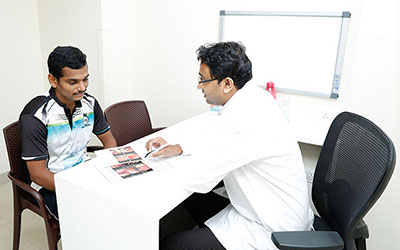 The latest Endoscopic procedures are done for gastrointestinal bleed, gastrointestinal cancers, foreign body removal, etc. Endosonography and Capsule Endoscopy are available too.
The latest Endoscopic procedures are done for gastrointestinal bleed, gastrointestinal cancers, foreign body removal, etc. Endosonography and Capsule Endoscopy are available too.- The Gastrointestinal surgeon manages major treatments related to gastrointestinal surgical problems of the intestines, pancreas, and hepatobiliary tract [liver and gallbladder] including cancers, many of them through Minimal Access surgery.
Upper GI Endoscopy
Upper GI endoscopy is a procedure that uses a flexible endoscope to visualize the upper GI tract. The upper GI tract includes the esophagus, stomach, and duodenum – the first part of the small intestine.
Applications:
Treating diffused mucosal bleed with Argon plasma coagulation (APC)
Dilation of the narrowed food pipe (Balloon dilation of stricture and achalasia cardia)
Metallic stenting of narrowed segments of food pipe or stomach
Removal of polyps (polypectomy)
Creating an alternative pathway for feeding directly to the stomach (PEG) or small intestine (PEG-J)
Draining fluid collections through the stomach (Cystogastrostomy) in patients with pancreatitis
What problems can Upper GI Endoscopy Detect?
Upper GI Endoscopy can be used to determine the cause of:
- Abdominal Pain
- Nausea
- Vomiting
- Swallowing difficulties
- Gastric reflux
- Unexplained weight loss
- Anemia
- Bleeding in the upper GI tract
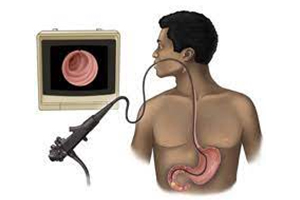
It is used for both diagnostic and therapeutic procedures.
Diagnostic upper GI endoscopy is done to detect:
- Ulcers
- Abnormal growths
- Obstruction
- Inflammation
- Hiatal hernia
The following therapeutic (treatment) procedures are also performed through upper GI endoscopy:
- Foreign Body Removal
- Treat bleeding ulcers by
a. injection of medication (injection therapy)
b. application of heat (coagulation) or
c. application of clips (hemoclips) to the bleeding vessel - Treat bleeding varies (engorged veins in liver disease) by applying plastic rings (EVL)
- Glue injection for gastric varix
Capsule Endoscopy
Capsule endoscopy can help in visualizing and evaluating the lining of the middle part of the gastrointestinal tract, which includes the three portions of the small intestine (duodenum, jejunum, and ileum).
What Problems Can Capsule Endoscopy Be Used To Diagnose?
Capsule endoscopy evaluates the small intestine. This part of the bowel cannot be reached by traditional upper endoscopy or by colonoscopy. The most common reason for doing capsule endoscopy is
- to identify cause of bleeding from the small intestine
- for detecting polyps
- diagnosing inflammatory bowel disease (Crohn’s disease)
- diagnosing small bowel ulcers
- detecting tumors of the small intestine
.jpg)
How Is Capsule Endoscopy Done?
A sensor device is applied and fastened to your abdomen with adhesive sleeves (similar to tape). The capsule endoscope is swallowed and as it passes naturally through your digestive tract, it transmits video images to a data recorder worn on your belt for approximately eight hours. At the end of the procedure, you will return to the office and the data recorder is removed so that images of your small bowel can be put on a computer screen for the physician’s review.
Enteroscopy
Enteroscopy is a procedure used to examine the small intestine (small bowel).
Why is this test performed?
This test is most often performed to help diagnose diseases of the small intestines. It may be done if you have:
- Unexplained diarrhea
- Unexplained gastrointestinal bleeding
- Abnormal barium meal follow-through (BMFT) or CT enteroclysis reports
- Tumours in the small intestines
How is the test performed?
A thin, flexible tube (endoscope) is inserted through the mouth or nose and into the upper gastrointestinal tract. During a single-balloon enteroscopy, a balloon attached to the endoscope can be inflated to allow the doctor to view the entire small bowel. Tissue samples removed during enteroscopy are sent to the laboratory for examination.
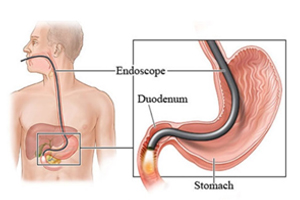
Colonoscopy
Colonoscopy is a procedure used to see inside the colon and rectum.
What problems can colonoscopy detect?
Colonoscopy can help doctors diagnose the reasons for
- Unexplained changes in bowel habits
- Abdominal pain
- Bleeding from the anus
- Unexplained weight loss
Colonoscopy can also detect inflamed tissue, ulcers, and abnormal growths.
The procedure is used to look for early signs of colorectal cancer. The doctor can also take samples from abnormal-looking tissues during colonoscopy. The procedure, called a biopsy, allows the doctor to later look at the tissue with a microscope for signs of disease.
Colonoscopy can be used to:
- Remove polyps (polypectomy)
- Dilate narrowed segments (stricture dilation) of the large intestine and place metallic stents across them (colonic stenting)
- Banding for hemorrhoids (piles banding)

How is Colonoscopy Performed?
During a colonoscopy, patients lie on their left side on an examination table. The doctor inserts a long, flexible, lighted tube called a colonoscope, into the anus and slowly guides it through the rectum and into the colon. The scope inflates the large intestine with carbon dioxide gas to give the doctor a better view. A small camera mounted on the scope transmits a video image from inside the large intestine to a computer screen, allowing the doctor to carefully examine the intestinal lining. The doctor may ask the patient to move periodically so the scope can be adjusted for better viewing.
Once the scope has reached the opening to the small intestine, it is slowly withdrawn and the lining of the large intestine is carefully examined again. Bleeding and puncture of the large intestine are possible but they are uncommon complications during colonoscopy.
Endoscopic Retrograde Cholangiopancreatography (ERCP)
ERCP enables the physician to diagnose problems in the gallbladder, bile ducts, and pancreas. The liver is a large organ that makes a liquid called bile that helps with digestion. The gallbladder is a small, pear-shaped organ that stores bile until it is needed for digestion. The bile ducts are tubes that carry bile from the liver to the gallbladder and small intestine. These ducts are called the biliary tree. The pancreas is a large gland that produces chemicals that help with digestion and also secretes hormones such as insulin.
Applications:
ERCP is primarily used as a therapeutic procedure for the treatment of diseases of
Bile Duct
- extraction of bile duct stones by balloon/basket (balloon/basket extraction)
- by crushing large bile stones and retrieving them (mechanical lithotripsy)
- relieving jaundice due to bile duct narrowing by dilating passage with a balloon (balloon dilation)
- treatment of bile duct infection (cholangitis) by draining pus by cutting open bile duct opening (biliary sphincterotomy) and placing stents /catheter in bile duct for free drainage of bile into the duodenum ( plastic stent/ENBD placement)
- stopping leakage of bile in bile duct injuries as a result of trauma and surgery
- metallic stent placement for relief of itching and jaundice in the bile duct, pancreatic, gallbladder cancers (metallic stent placement)
Pancreas
- relief of pain in chronic pancreatitis
- by removal of pancreatic duct stones
- dilating the narrowed pancreatic duct
- placing of stents to facilitate drainage of infected fluid collection in pancreatitis (Pseudocyst drainage)
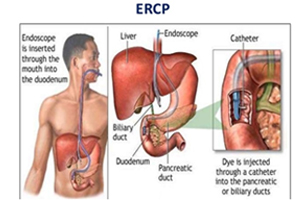
How is ERCP performed?
ERCP combines the use of X-rays and an endoscope, which is a long, flexible, lighted tube. Through the endoscope, the physician can see the inside of the stomach and duodenum, and inject dyes into the ducts in the biliary tree and pancreas so they can be seen on X-rays.
For the procedure, you will lie on your left side on an examining table in an X-ray room. You will be given medication to help numb the back of your throat and a sedative to help you relax during the examination. You will swallow the endoscope, and the physician will then guide the scope through your esophagus, stomach, and duodenum until it reaches the spot where the ducts of the biliary tree and pancreas open into the duodenum. At this time, you will be turned to lie flat on your stomach, and the physician will pass a small plastic tube through the scope. Through the tube, the physician will inject a dye into the ducts to make them show up clearly on X-rays. X-rays are taken as soon as the dye is injected.
Endoscopic Ultrasonography
Endoscopic Ultrasonography [EUS] is an imaging technique that combines endoscopy with ultrasonography. EUS is performed using an endoscope with a small ultrasound machine attached to the tip of the endoscope. The endoultrasound probe is passed through the mouth or anus to the area to be examined under endoscopic view. The ultrasound component is then utilized to examine the walls and the surrounding structures of the upper and lower gastrointestinal tract. The esophagus, stomach, duodenum, and rectum are the organs that are studied by this equipment. EUS is also used to study internal organs that lie next to the gastrointestinal tract, such as the mediastinum, gallbladder, biliary tract, and pancreas.
Benefits of EUS
- EUS provides detailed images of the anatomy of the digestive tract.
- EUS can be performed to further evaluate the pancreas when abnormalities are noted on CT or conventional abdominal ultrasonography.
- EUS can also be performed to evaluate abnormal areas in the esophagus, stomach and duodenum noted on either endoscopy or an X-ray examination.
- EUS is the only investigation that shows the gastrointestinal wall as a layered structure as seen in microscopic examination of tissues. This feature is helpful to understand the exact nature of the pathology.
Applications of EUS
- EUS can help determine the extent of certain malignancies of the gastrointestinal tract. These include cancer of the esophagus, pancreas, stomach, and rectum. EUS provides information as to the depth of involvement of cancer.
- EUS shows if malignant cells have invaded the walls of the GI tract or whether malignancy has spread to adjacent lymph nodes or nearby vital structures such as major blood vessels.
- EUS is the only investigation that can identify lymph nodes smaller than 1cm. EUS can help determine the need for or avoidance of surgical procedures.
- EUS helps to differentiate a malignant lymph node from a tuberculous lymphnode particularly in the mediastinum.
Applications of EUS in Evaluation of the Common Bile Duct
- EUS is a very useful tool to evaluate CBD. Abnormalities like tumors, stones, and dilatation of CBD can be detected.
- Microlithiasis in CBD and gallbladder can be detected and EUS is the only test that detects microlithiasis. Microlithiasis of the gallbladder is an important cause of biliary pancreatitis.
.jpg) EUS for Management of Pseudocyst of Pancreas
EUS for Management of Pseudocyst of Pancreas
EUS is the most appropriate treatment of choice for the drainage of the pseudocyst of the pancreas.
EUS can clearly show
the type of cyst, its contents, and also whether there is any blood vessel on the needle track during the puncture.
It is possible to deploy a stent inside the cyst from the stomach.
Services Offered
The list of Diagnostic and Therapeutic Procedures performed in the Endoscopy Unit:
- Upper GI – Esophagus (Food pipe), Stomach & part of Small Intestine:
-Diagnostic Upper GI Endoscopy
-Therapeutic Upper GI Endoscopy
- Liver, Gall Bladder & Pancreas:
-ERCP : Diagnostic
-Therapeutic ERCP - Small Intestine:
-Diagnostic Small Intestinal Endoscopy (push enteroscopy) - Large Intestine:
-Diagnostic Colonoscopy
-Therapeutic Colonoscopy
-Diagnostic Sigmoidoscopy
-Therapeutic Sigmoidoscopy (Rigid) with banding - Endosonography:
-Endosonography with FNAC
-Endosonography therapeutic - Others:
-PEG (Percutaneous Endoscopic Gastrostomy)
-Psedocyst Drainage
-Pancreatic Necrosectomy
Specialists

DR. VINEET CHAUDHARI
GASTROENTEROLOGIST
M.D. (Medicine), D.N.B. (Gastroenterology)
View details
Appointment
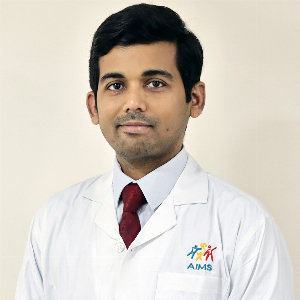
DR. BISWA PATRA
GASTROENTEROLOGIST
M.B.B.S. M.D.( Internal Medicine ), D.M.( Medical Gastroenterology),Endoscopic Resection and Magnifying Endoscopy Fellowship
View details
Appointment
ABOUT US
About AIMSDirector's Message
Vision & Mission
Accreditations
Awards & Accolades
Our Network
Phone Directory
Designed by Web Creations 2022. All rights reserved.










